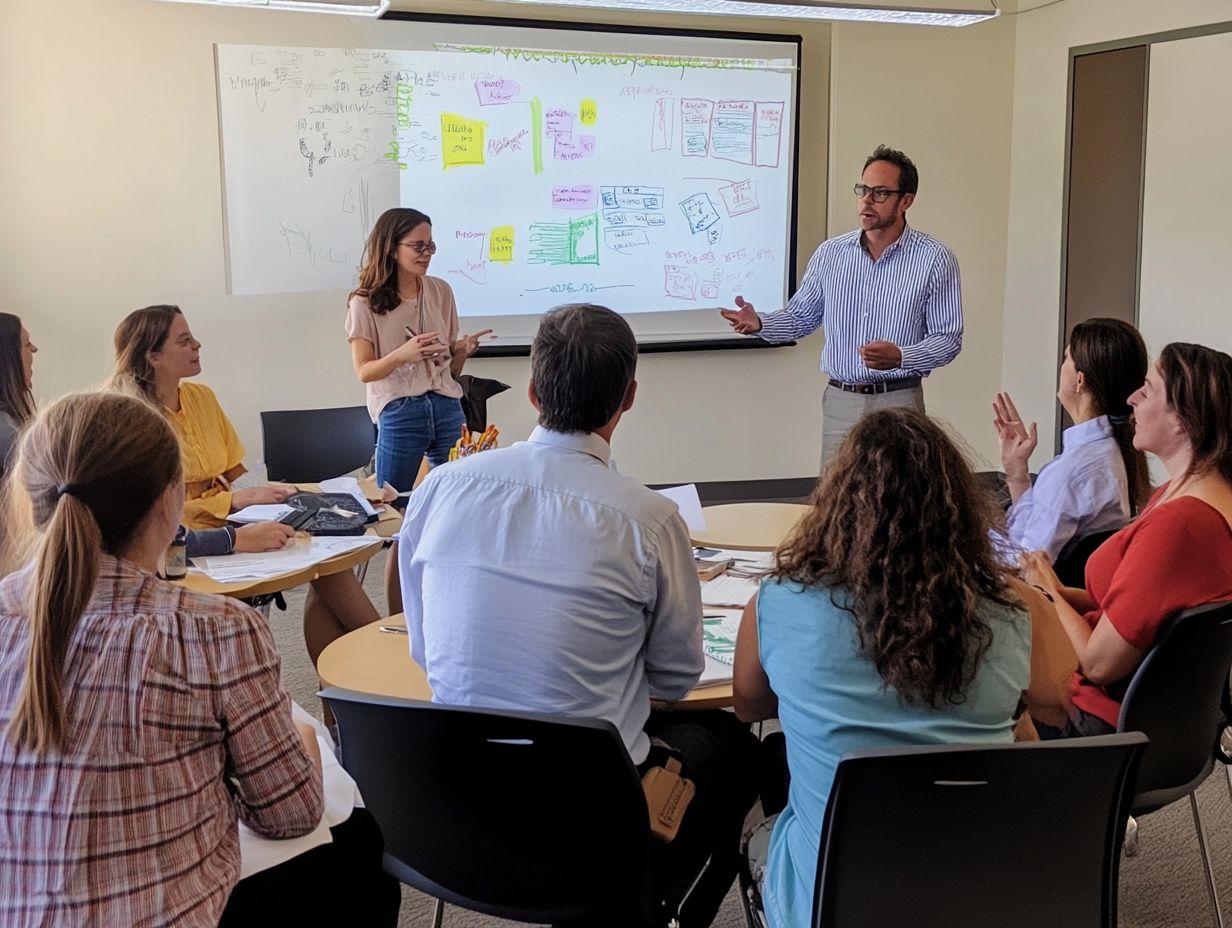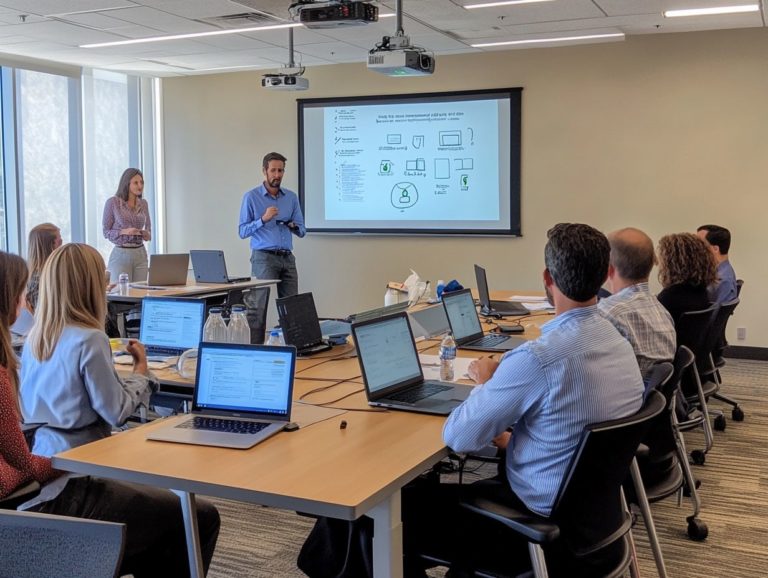how to use feedback to improve training
Feedback transforms training! It is essential for crafting effective programs, significantly enhancing the learning experience and outcomes for participants.
Recognizing the different types of feedback verbal, written, or visual can profoundly affect how you absorb information.
This article explores best practices for delivering impactful feedback, provides strategies for integrating it into your training, and highlights methods for assessing its effectiveness.
Discover how harnessing feedback can elevate your training approach and drive lasting improvements.
Contents
- Key Takeaways:
- The Importance of Feedback in Training
- Types of Feedback in Training
- Best Practices for Using Feedback in Training
- Incorporating Feedback into Training Programs
- Measuring the Impact of Feedback on Training
- Frequently Asked Questions
- 1. How important is feedback for improving training?
- 2. What are some ways to collect feedback for training?
- 3. How should trainers handle negative feedback?
- 4. How often should feedback be incorporated into training?
- 5. What are some tips for using feedback to improve training?
- 6. Can feedback be used to measure the success of training?
Key Takeaways:

Feedback is crucial in training as it helps learners understand their progress and identify areas for growth. Different types of feedback, whether verbal, written, or visual, enhance learning outcomes. To optimize feedback’s impact, training programs should adopt best practices, such as delivering specific and timely feedback and creating a safe learning space.
The Importance of Feedback in Training
Feedback is vital for improving training programs in your organization, offering valuable insights into performance and areas for growth.
By creating a space that encourages regular, constructive feedback, you enhance employee engagement and foster a culture of continuous development.
This proactive approach sharpens skills and boosts employee satisfaction and retention, ultimately enhancing your organization s overall performance.
Understanding the Role of Feedback in Learning
Understanding feedback’s role in learning is essential for continuous improvement and enhanced performance within your organization.
Feedback serves as an important tool that sharpens individual skills and cultivates an atmosphere of open communication and engagement.
By using techniques such as peer feedback, you and your colleagues can share experiences and insights, fostering a collaborative growth environment.
Utilizing anonymous surveys encourages honest responses, allowing you to express your opinions without fear. These varied feedback methods play a crucial role in training effectiveness, promoting personal development and a strong feedback culture that aligns efforts with organizational goals.
Types of Feedback in Training
There are various types of feedback essential to training, including verbal, written, and visual feedback.
Each type serves a unique purpose, enhancing employee development and fostering engagement in organizations.
Verbal, Written, and Visual Feedback

Verbal, written, and visual feedback are vital components of effective training programs, each offering unique advantages to engage you and maximize your learning experience.
When you use verbal feedback during training sessions, you gain immediate, personalized insights, ensuring you feel supported and understood.
Adding written summaries provides a tangible resource to refer back to, enriching your retention of key concepts.
Visual feedback, such as infographics, simplifies complex information into digestible formats, catering to diverse learning styles. Video reviews offer a chance for self-assessment, allowing you to observe your progress and identify areas for improvement.
By integrating these methods, you significantly enhance your training’s effectiveness, making each session informative, engaging, and impactful.
Best Practices for Using Feedback in Training
Implementing best practices for feedback in training is crucial for organizations aiming to elevate employee engagement, enhance performance, and cultivate a culture of continuous improvement.
By focusing on these strategies, you create an environment where employees feel valued and motivated to grow, driving the success of your organization.
Start using feedback today to boost your training programs!
Effective Feedback Techniques
Effective feedback techniques are essential for cultivating a robust feedback culture within your organization. They allow employees to receive actionable insights that propel their performance forward.
Use models like the Situation-Behavior-Impact (SBI) framework to create an environment where feedback is not just welcomed but actively pursued. This framework helps people understand how their actions affect others, paving the way for meaningful growth.
Establishing ongoing feedback loops ensures that communication flows seamlessly, reinforcing engagement and continuous learning. In such a nurturing atmosphere, employees feel enabled to hone their skills and elevate their contributions. This ultimately enhances overall team performance and drives organizational success.
Incorporating Feedback into Training Programs
Incorporating feedback into your training programs is essential for creating impactful learning experiences that foster continuous development and boost employee engagement.
By actively seeking and integrating feedback, you position your organization to cultivate a culture of growth and innovation. This ensures that every training initiative resonates with your team and drives meaningful results.
Strategies for Implementing Feedback

Implementing effective feedback strategies in your training programs can significantly elevate employee engagement and cultivate a proactive feedback culture within your organization.
By incorporating regular employee surveys, you can gather valuable insights into the effectiveness of your training initiatives and identify areas that may need improvement. Utilizing pulse surveys provides you with real-time feedback, allowing for swift adjustments that meet the evolving needs of your employees.
Fostering open communication encourages a two-way dialogue, enhancing trust and increasing employees’ willingness to share their thoughts. These methods not only boost employee satisfaction but also contribute to a cycle of continuous improvement and skill development.
This creates a more dynamic and responsive workplace environment.
Measuring the Impact of Feedback on Training
Measuring the impact of feedback on training is essential for your organization. It allows you to evaluate the effectiveness of your training programs and make informed decisions that drive continuous improvement.
Acting now to measure feedback can transform your training programs and enhance overall performance.
Evaluating and Adjusting Feedback Methods
Evaluating and adjusting your feedback methods is crucial for keeping training programs relevant and effective in driving performance improvement.
By systematically reviewing these feedback mechanisms, you can uncover valuable insights that pinpoint areas needing enhancement. Regular assessments capture employee perspectives and instill a sense of ownership among your staff regarding their development opportunities.
When employees recognize that their input is valued, it nurtures a culture of continuous improvement one where training effectiveness and job satisfaction can truly thrive.
Creating strong feedback loops lets you make quick updates that keep your training fresh and effective, ensuring that your training content meets current needs and anticipates future challenges.
Frequently Asked Questions
1. How important is feedback for improving training?

Feedback is essential for improving training. It provides insights into what works and what doesn’t, allowing trainers to make necessary adjustments.
2. What are some ways to collect feedback for training?
There are various ways to collect feedback, such as conducting post-training surveys, using feedback forms, scheduling one-on-one meetings with trainees, or using online feedback tools. It’s essential to choose a method that works best for your training program and trainees.
3. How should trainers handle negative feedback?
Trainers should not take negative feedback personally. Instead, they should approach it with an open mind, as it can provide valuable understanding.
Negative feedback highlights areas for improvement. Trainers can use it to make necessary changes and enhance their training programs.
4. How often should feedback be incorporated into training?
Incorporate feedback regularly into training sessions. Collect it during and after each session for immediate improvements.
This helps gather overall insights into the training program s effectiveness.
5. What are some tips for using feedback to improve training?
First, gather feedback from a diverse group of trainees for a well-rounded perspective. Next, take time to analyze and understand this feedback.
Involve trainees in the feedback process and clearly communicate any changes based on their input.
6. Can feedback be used to measure the success of training?
Yes! Feedback serves as a crucial measure of training success. It offers insights into trainees’ satisfaction and knowledge retention.
By incorporating feedback, trainers can continuously improve and ensure their training meets the desired objectives.






